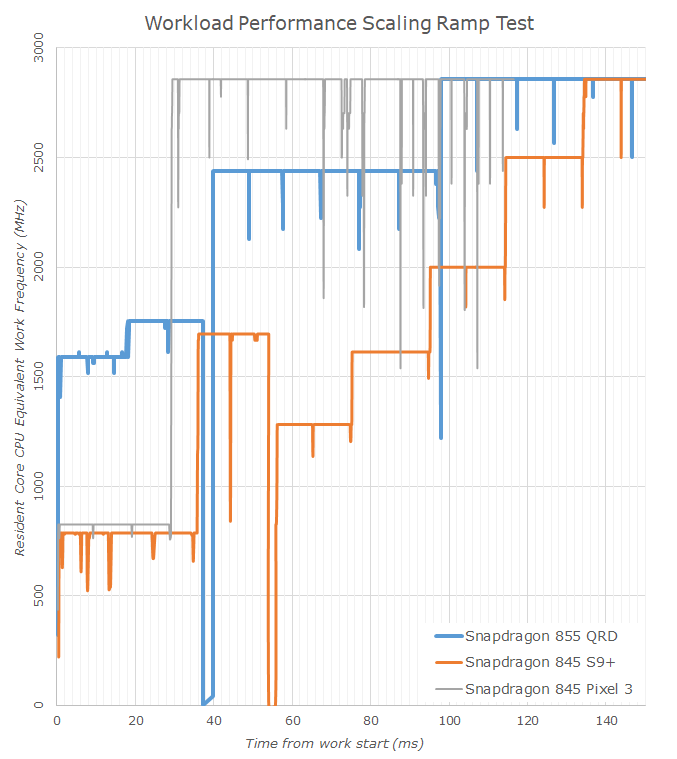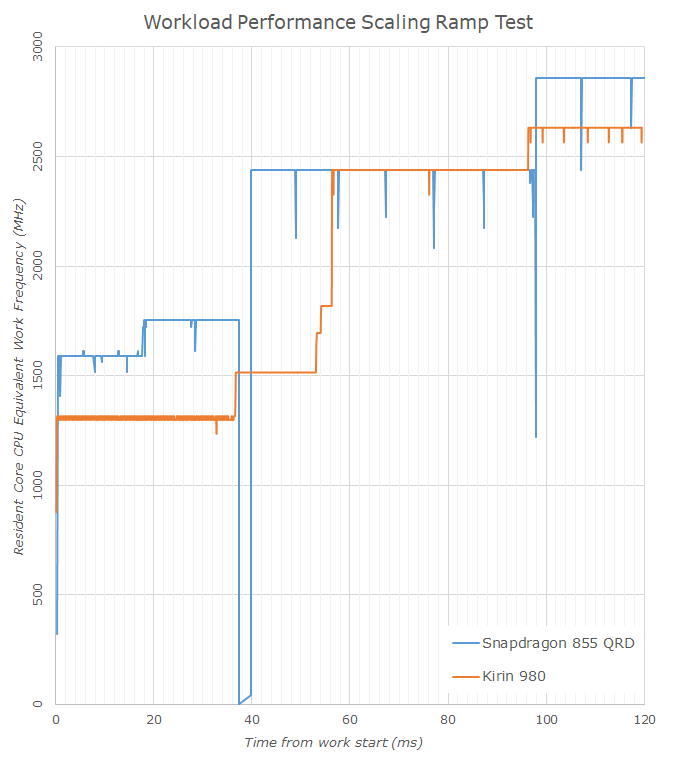The Snapdragon 855 Performance Preview: Setting the Stage for Flagship Android 2019
by Andrei Frumusanu on January 15, 2019 8:00 AM EST- Posted in
- Mobile
- Qualcomm
- Smartphones
- SoCs
- 7nm
- Snapdragon 855
System Performance - Slightly Underwhelming?
While synthetic steady state workloads are one thing, real-world workloads are more transactional and their performance is determined not just by hardware, but as well by software. Here things like the CPU scheduler and OS APIs can have a big effect on the resulting perceived performance of a device.

Starting off with PCMark’s Web Browsing 2.0 test, the Snapdragon 855 goes off to a bad start. Here for some reason the S855 QRD wasn’t able to distinguish itself from the lower end of Snapdragon 845 devices – here we had expected the phone to perform and compete similarly to the Kirin 980 in the Mate 20’s.

The video editing score is again also quite mediocre, but again the reason for this is that this test has largely reached a performance plateau where most of today’s devices no longer really showcase meaningful differences between each other.

The writing sub-test is among one of the most important in PCMark, and luckily here the Snapdragon 855 QRD performed as expected as it’s within range of the Mate 20’s.

The photo editing sub-test is characterised by shorter heavy RenderScript workload bursts. The QRD performs well, although it’s within the results of the top Snapdragon 845 devices.

Finally in the data manipulation result which is more single-thread bound, we see the Snapdragon 855 perform well, but still remains neck-and-neck with the Kirin 980 devices as well as behind the Pixel 3’s very aggressive scheduler implementation.

Overall, the Snapdragon 855 QRD in PCMark ended up among the top scorers, however I found the result to be a bit disappointing as it doesn’t appear to achieve a higher ranking than the Pixel 3, and Huawei’s Kirin 980 Mate 20’s are also ahead.


I’ve discussed the results with Qualcomm, and they were surprised to see the numbers end up like this. They stated that it’s something they will look into, and stated that it’s possible that the scheduler and software stack on commercial devices might improve performance. Something to be revisited once we get our hands on the first phones.
The web-based benchmarks such as Speedometer 2.0 and WebXPRT 3 showcase similar relatively muted results. Here I had expected Qualcomm to perform really well given the scheduler performance showcase of the Snapdragon 845. The results of the Snapdragon 855 are quite meagre, especially in a steady-state throughput workload such as Speedometer 2.0. Here the Snapdragon 855 only manages to showcase a ~17% improvement over the last generation, and also lags behind the Kirin 980 by some notable amount.
Performance Scaling Ramp Test
One of the newer kind of tests I introduced last year and has used in our review of the Apple iPhone XS is the scaling ramp test – here showcasing the improved DVFS responsivity of iOS12 across several generations of iPhones.
I’ve quickly ran this on the S855 QRD to be able to get a sense of the scheduler and DVFS mechanism:
Here we see the Snapdragon 855 QRD being able to scale from a sleeping idle workload state to its maximum performance state in around 100ms. To compare this, I also showcase the scaling behaviour of the S845 in both the S9+ as well as the Pixel 3. The difference between the Pixel 3’s aggressive boost behaviour and the S9’s more step-wise frequency scaling showcases the best visual representation of the perceived responsiveness difference between the two devices.
The Snapdragon 855 here falls somewhere in-between both. It’s to be noted that the workload does get boosted to an “efficient” big core at 2.45GHz in around 40ms which is a very fast scaling behaviour.
Comparing the Snapdragon 855 against the Kirin 980, we see that the Snapdragon isn’t any slower in reaching the maximum performance states. What is odd in these results is that the workload sees a significant pause of ~2.4ms when migrating over from the little cores, something that seems to affect only devices with Qualcomm’s custom scheduler. It’s an interesting find that I’ll have to investigate more.
Overall, real-world performance of the Snapdragon 855 is a bit lower than I had expected it to be. I’m not exactly sure what the cause here is; on the scheduler side we’ve verified that the workload doesn’t inherently scale slower than the Kirin 980. The only other explanation I could see is that we might be seeing some disadvantage of the smaller L3 cache or even the higher DRAM latency.
As we’ve seen in past Snapdragon performance previews, final commercial device performance is subject to change, and it’s possible the performance situation will be more tuned in actual shipping phones.












132 Comments
View All Comments
genekellyjr - Wednesday, January 16, 2019 - link
You might be clueless too! There weren't any "4k rendering" benchmarks in that link - but there were 4k encoding benchmarks.And as for that encoding performance you are apparently referencing, it is definitely using fixed function encoders - it's not the CPU performance as Geekbench tests use (and I want to stress cross-platform Geekbench isn't 1:1 scoring - you'll never find Andandtech comparing various CPU architectures with Geekbench as it even uses fixed function resources like AES in its crypto stuff). And the speeds the laptops show definitely point to a CPU encoder being used. A fixed function encoder will barely hit the CPU, while CPU encoding will max those cores at 100%. The CPU encoding is higher quality at the cost of heat and speed.
Recently Adobe updated Premier to support Intel's fixed function encoder (called quick sync) read here http://www.dvxuser.com/V6/showthread.php?362263-Ad... post #8 - and Rush may not have gotten that update yet or the benchmark site referenced didn't update their program https://www.laptopmag.com/reviews/laptops/new-ipad... but I managed to find a benchmark for the quick sync in Premier https://forums.creativecow.net/thread/335/101459 - and Intel's quick sync fixed function stuff is all relatively the same afaik so the desktop CPU has less of an impact - gives a 1:20 min 4K -> 1080p conversion at 91 sec w/ CPU and 45 sec w/ fixed function, scale that up to 12 min (x9) and we get 13:39 w/ CPU (it's a nice CPU, i7-8700K) and the fixed function encoder gets 6:45. It'll probably scale pretty linearly. So 6:45 vs 7:47 with fixed function encoding - which isn't comparing CPUs at all at this point but rather their fixed function encoder!
So the iPad has some nice hardware, sure, but it's not outperforming Intel's brand new MB Pro 13" by leaps and bounds. They'll probably be about the same speed with fixed function encoding and the MB Pro 13" will win in a non-encoder setting thanks to its increased TDP.
darkich - Friday, January 18, 2019 - link
Okay.. So in short, the A12X is "about the same" in CPU performance as Intel's actively cooled, CPU-specific and twice more power hungry chip while also having a 1+TFLOPS GPU, 4G modem and advanced ISP on the same die.Overall, if that is what you call "nice", then Intel's hardware is what?
Trash.
Rudde - Friday, January 18, 2019 - link
Let's compare Intel i7-8500Y and Apple A12X. The i7-8500Y is a dual core 5W 14nm notebook/tablet processor. A12X is a octa core 7nm tablet processor with unknown power usage. 8500Y uses the x86-64 instruction set, while A12X uses ARMv8. They have very few benchmarks in common, which introduces notable amounts of uncertainty.Let's start with Geekbench 4.1/4.2 Single threaded:
8500Y scored 4885 and A12X 4993. A12X leads with 2%, which is within margin of error.
Same benchmark, but multithreaded:
8500Y scored 8225 and A12X 17866. A12X demolishes the dual core with 117% higher performance. This is clearly because of the 4-core-cluster in A12X having double core count compared with the dual core 8500Y.
Next up we have Mozilla Kraken 1.1 showing browser performance:
8500Y scores 1822ms and A12X 609ms. The A12X took 67% less time to complete the task, which amounts to a 199% increase in performance.
Octane V2 is another browser performance benchmark:
8500Y scores 24567 and A12X 45080. A12X bests the Intel cpu by 83%.
3D Mark has two versions of Ice Storm Physics and unfortunately our processors use different versions. They use the same resolution however.
8500Y scores 25064 in standard physics and A12X 39393 in unlimited physics. A12X scores a 57% lead.
It's hard to establish system performance with such a limited amount of benchmarks. Geekbench and 3DMark are synthetics and the two others show browser performance.
The processors are equal in ST, but the A12Xs higher core count allows it to double the 8500Ys MT score. The A12X outpaces the 8500Y in 3dMark. The A12X is clearly superior in browser performance. Apples A12 drops closer to the Intel in synthetics, but performs similar to it's larger sibling in web benchmarks.
Winner: A12X
Nemaca - Tuesday, January 15, 2019 - link
Overall, the 855 was thought to be head and shoulders above Kirin, but it seems that it will be on the same level at best.I'm typing this from my already heavily used mate 20pro, so if the US wouldn't nuke Huawei global-wide right now, the Kirin would certainly push ahead, which I hope it will do, since it seems more competitive price-wise.
Huawei bypassed the power issue with larger batteries, but to be honest, the Kirin doesn't seem to be that hungry anyway.
For me, the 855 is a letdown, I was hoping for more, but it seems my mate20pro will be relevant for longer then I thought, so not too bad of a news, I guess.
Thank you, Andrei, for the in-depth review!
Achtung_BG - Wednesday, January 16, 2019 - link
Snapdragon 855 .......https://youtu.be/mqFLXayD6e8
darkich - Tuesday, January 15, 2019 - link
This here proves once and for all that your system performance benchmarks are just bogus and irrelevant.Are we seriously supposed to believe that Snapdragon actually made a lower performing chipset than their previous one?
BS
darkich - Tuesday, January 15, 2019 - link
*Qualcomm, not SnapdragonIcehawk - Tuesday, January 15, 2019 - link
It's happened before in the chase for efficiencynpp - Tuesday, January 15, 2019 - link
I really doubt we’ll see battery life improve much with this generation. Hint - 5G. Maybe that’s why 855 focuses on overall efficiency, and the GPU gains are modest. Let’s hope I’m wrong.Impulses - Tuesday, January 15, 2019 - link
Yeah, that's the big wrench in the works... Hopefully there's at least *some* flagships without 5G! Though I doubt I'll be looking for an upgrade from my Pixel 3 this year or next.